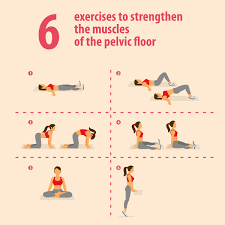A nurse is providing teaching about Kegel exercises to a group of clients who are in the third trimester of pregnancy. Which of the following statements by a client indicates understanding of the teaching?
"These exercises help pelvic muscles to strengthen and stretch during birth."
"These exercises help prevent constipation during pregnancy."
"They can help reduce back aches throughout pregnancy."
"They can prevent further stretch marks on my abdomen."
The Correct Answer is A
Choice A: Kegel exercises are specifically designed to strengthen the pelvic floor muscles, which play a crucial role during childbirth. Strengthening these muscles can aid in better control during labor and delivery, facilitating stretching and reducing the risk of injury.
Choice B: Kegel exercises do not have a direct impact on preventing constipation during pregnancy. However, they may help improve bowel control and prevent fecal incontinence.
Choice C: While Kegel exercises can improve posture and core strength, their primary benefit lies in strengthening the pelvic muscles, not directly reducing backaches throughout pregnancy.
Choice D: Kegel exercises are not intended to prevent stretch marks on the abdomen. Stretch marks are caused by the stretching of the skin during pregnancy and are not related to pelvic muscle exercises.

Nursing Test Bank
Naxlex Comprehensive Predictor Exams
Related Questions
Correct Answer is C
Explanation
A. "Increase your intake of ironrich foods and take a prenatal vitamin."
Important, but not directly related to reducing the risk of neural tube defects. Ironrich foods and prenatal vitamins are essential for overall maternal and fetal health, but they do not specifically target neural tube defect prevention.
B. "Avoid any alcohol consumption."
Important advice during pregnancy to prevent fetal alcohol spectrum disorders, but not directly related to reducing the risk of neural tube defects.
C. "Take a folic acid supplement for at least 3 months before you get pregnant."
Correct: Adequate folic acid intake before conception and during early pregnancy can significantly reduce the risk of neural tube defects in newborns.
D. "Avoid all foods containing aspartame."Aspartame is an artificial sweetener that has been studied for safety in pregnancy, and there is currently no strong evidence linking it to neural tube defects. However, it's still a good idea
to limit the intake of artificial sweeteners during pregnancy and focus on a balanced diet.
Correct Answer is D
Explanation
Choice A: While rubella can lead to complications like encephalitis, this answer does not address the reason for isolation precautions for the newborn.
Choice B: While rubella can suppress the immune response in general, it does not explain the need for isolation of the newborn specifically.
Choice C: TORCH (Toxoplasmosis, Rubella, Cytomegalovirus, and Herpes) infections are a group of infections that can be transmitted from mother to fetus during pregnancy. While rubella is part of the TORCH infections, this answer does not specifically address the reason for isolation of the newborn after delivery.
Choice D: Rubella, also known as German measles, is a contagious viral infection. Newborns born to mothers with rubella can be at risk because the virus can be transmitted to them during delivery. The newborn might be actively shedding the virus, which is why isolation precautions are necessary to prevent the spread of the infection to other vulnerable newborns or individuals.
Whether you are a student looking to ace your exams or a practicing nurse seeking to enhance your expertise , our nursing education contents will empower you with the confidence and competence to make a difference in the lives of patients and become a respected leader in the healthcare field.
Visit Naxlex, invest in your future and unlock endless possibilities with our unparalleled nursing education contents today
Report Wrong Answer on the Current Question
Do you disagree with the answer? If yes, what is your expected answer? Explain.
Kindly be descriptive with the issue you are facing.
